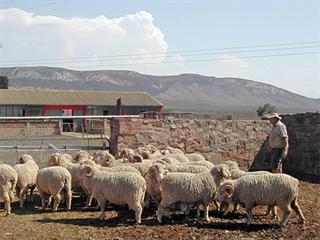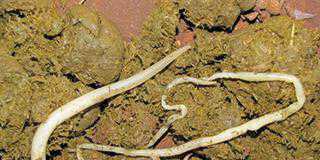
For many years, the Merino was bred solely for wool. In recent decades, however, farmers have been selecting for meat as well in order to increase their profit. As a result, the modern Merino has fewer skin pleats and carries less wool than its ancestors. But, thanks to careful breeding, the wool is finer and longer, while ewes are larger and more fertile.
Picking out a good Merino sire is not a simple exercise, however. Firstly, it’s difficult to check the conformation, as the body is disguised by long wool. Conformation is important because, despite the current relatively high wool price, Merino farmers earn more than two-thirds of their income from mutton. Secondly, the fleece has to be inspected for a variety of characteristics, including fineness, length, wool mass, clean yield and uniformity. Quality Merino wool is a very special fibre, and is quite scarce.
One animal – two products
A dual-purpose sheep gives the farmer the best of both worlds. Lamb and mutton prices on the local market are reasonably high, while Merino wool destined for the export market – a luxury product – can fetch a very good price indeed.
Farming Merinos means that the farmer obtains two products from the same animal – three, including the skin. That means diversification without changing land use and without necessarily using more permanent labour. Being able to market meat and wool also improves cash flow, especially if most of the flock is shorn every eight months.
Selection
So, let’s say you’ve been persuaded to sell some cattle and use the money to buy a flock of decent Merino ewes. Or perhaps you want to upgrade your current flock. How do you go about selecting the best rams for your ewes? To begin with, look for an animal with the fewest faults and remember that picking the wrong ram can hit your income severely. His genes will spread throughout the flock, a problem that can be difficult to fix.
Stud rams can cost tens of thousands of rand, but a reasonably good flock ram will cost anything from R2 500 to R6 000. You will need three to four rams per 100 ewes. Selecting Merinos is not something you can learn from a book. It would be better to ask an experienced farmer or wool brokers’ specialist to help you for the first few years. However, accumulating some theoretical knowledge will at least help you to understand what the process entails and allow you to learn faster.
Inspecting the rams
The first step is to decide from which breeder to buy your rams. Rams are readily available at ram sales, where you’ll have to bid against other buyers. In this case, you can inspect the rams before the auction starts, giving you the opportunity to mark a few on the catalogue and decide what you are prepared to pay for them. Alternatively, you might be able to get onto a waiting list that will allow you to buy rams on a farm at a predetermined price. When you buy on the farm, the breeder usually classes the available rams into price lots, depending on value.
Know the breeder
Whichever option you choose, do your homework about the breeder. What type of rams does he breed? Will they thrive under your particular conditions? Does the breeder have a good reputation? If you buy directly from the farm, have a good look at the breeder’s other animals. Ask yourself if the ewes you see are the type you would like to have.
Environmental conditions
You won’t go far wrong if you buy good genetic material from a reputable breeder. A useful rule of thumb is to buy rams reared in the same conditions under which you would raise your lambs. In other words, if your flock is run under relatively intensive conditions on a high nutrition plan, it’s fine to buy rams that have been pampered and well-fed.
On the other hand, if your sheep run on semi-arid veld without much supplementary feed, buy ‘veld rams’, which have had to grow up in a natural environment. They will be smaller than the fed rams, but will perform better in harsher conditions.
Roelof Bezuidenhout is a freelance agricultural writer and a fourth-generation Karoo small-stock farmer specialising in Merino and Dorper sheep and Angora goats.













